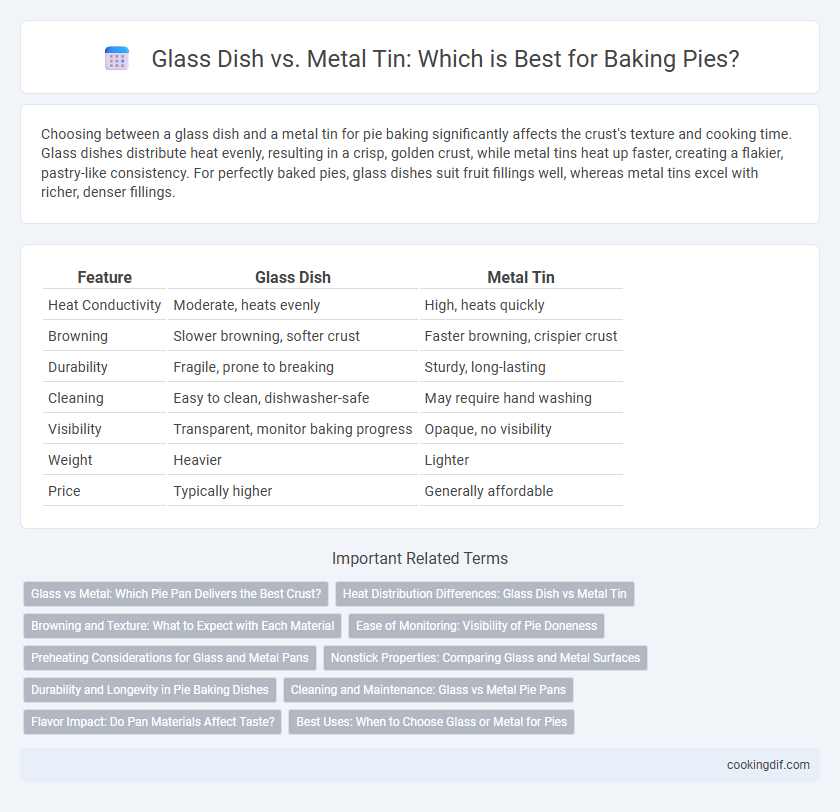Choosing between a glass dish and a metal tin for pie baking significantly affects the crust's texture and cooking time. Glass dishes distribute heat evenly, resulting in a crisp, golden crust, while metal tins heat up faster, creating a flakier, pastry-like consistency. For perfectly baked pies, glass dishes suit fruit fillings well, whereas metal tins excel with richer, denser fillings.
Table of Comparison
| Feature | Glass Dish | Metal Tin |
|---|---|---|
| Heat Conductivity | Moderate, heats evenly | High, heats quickly |
| Browning | Slower browning, softer crust | Faster browning, crispier crust |
| Durability | Fragile, prone to breaking | Sturdy, long-lasting |
| Cleaning | Easy to clean, dishwasher-safe | May require hand washing |
| Visibility | Transparent, monitor baking progress | Opaque, no visibility |
| Weight | Heavier | Lighter |
| Price | Typically higher | Generally affordable |
Glass vs Metal: Which Pie Pan Delivers the Best Crust?
Glass pie dishes provide even heat distribution, resulting in a thoroughly cooked crust with a golden edge, while metal tins heat up quickly and produce a crispier, browner crust. Glass retains heat longer, ensuring consistent baking but may cause slower crust browning compared to metal's rapid heat conduction. Choosing between glass and metal depends on whether a tender, evenly cooked crust or a crisp, robustly browned crust is preferred.
Heat Distribution Differences: Glass Dish vs Metal Tin
Glass dishes provide slower, more even heat distribution, resulting in a uniformly baked pie with a tender crust, while metal tins heat up faster and transfer heat more efficiently, promoting a crisper, browner crust. The thermal conductivity of metal allows rapid heat penetration, which is ideal for pies requiring a well-caramelized edge, whereas glass retains heat longer, maintaining steady cooking temperature. Choosing between glass and metal depends on desired crust texture and baking time adjustments due to their differing heat conduction properties.
Browning and Texture: What to Expect with Each Material
Glass dishes provide even heat distribution, resulting in consistent browning and a crisp crust for pies, while the transparency allows monitoring browning without opening the oven. Metal tins heat up faster and produce a flakier, more browned crust due to their superior heat conductivity but may require careful temperature control to prevent over-browning. Choosing between glass and metal depends on the desired texture and crust color, with glass offering a tender, evenly baked pie and metal delivering a golden, crispy finish.
Ease of Monitoring: Visibility of Pie Doneness
Glass dishes offer superior visibility during pie baking, allowing easy monitoring of crust color and doneness without opening the oven. Metal tins, in contrast, obscure the pie's appearance, requiring reliance on baking time and experience to assess readiness. This enhanced visibility in glass dishes helps prevent under- or over-baking, ensuring a perfectly baked pie.
Preheating Considerations for Glass and Metal Pans
Glass dishes require longer preheating times than metal tins due to their heat retention properties, ensuring even baking and preventing soggy crusts. Metal tins heat up quickly and respond faster to temperature changes, which can lead to browner, crisper crusts but may require careful temperature monitoring to avoid burning. Selecting the right preheating strategy for glass or metal pans can significantly impact pie texture and baking consistency.
Nonstick Properties: Comparing Glass and Metal Surfaces
Glass dishes offer a naturally nonstick surface due to their smooth, tempered glass, which helps prevent pie crusts from sticking while promoting even heat distribution for consistent baking. Metal tins, especially those made of seasoned or nonstick-coated aluminum or steel, enhance browning and crispiness but may require additional greasing or flouring to prevent sticking. Choosing between glass and metal depends on the desired crust texture and ease of pie removal, with metal tins favoring a crispier crust and glass dishes supporting gentle, even baking.
Durability and Longevity in Pie Baking Dishes
Glass dishes offer excellent durability for pie baking due to their resistance to scratches, stains, and chemical reactions, ensuring longevity with proper care. Metal tins, typically made from aluminum or stainless steel, provide robust construction that withstands frequent use but may warp or corrode over time without adequate maintenance. Both materials deliver reliable performance, but glass dishes retain their clarity and structural integrity longer, while metal tins excel in heat conduction and durability under high-temperature conditions.
Cleaning and Maintenance: Glass vs Metal Pie Pans
Glass pie dishes are non-porous, making them easy to clean and resistant to retaining odors or stains, which simplifies maintenance after baking. Metal pie tins, especially those without non-stick coatings, require thorough cleaning to prevent rust and food residue buildup, often needing more careful drying to avoid corrosion. Choosing glass minimizes long-term upkeep, while metal demands more attentive care to maintain durability and hygiene.
Flavor Impact: Do Pan Materials Affect Taste?
Glass dishes provide even heat distribution, resulting in a consistently baked pie crust with a slightly sweeter, caramelized flavor due to the slower heat transfer. Metal tins heat up quickly, producing a crisper and browner crust that enhances a buttery, toasted taste often preferred for fruit pies. The material of the pan influences the pie's flavor profile by altering the crust texture and baking dynamics, directly impacting the overall taste experience.
Best Uses: When to Choose Glass or Metal for Pies
Glass dishes excel in baking fruit pies and quiches, as their even heat distribution promotes thorough cooking and browning without burning the crust. Metal tins offer superior heat conductivity, making them ideal for pies with crisp, flaky crusts like pumpkin or pecan, where a golden, crunchy bottom is desired. Opt for glass when visual presentation matters, and choose metal for a faster bake and a more textured crust.
Glass dish vs metal tin for pie baking Infographic

 cookingdif.com
cookingdif.com